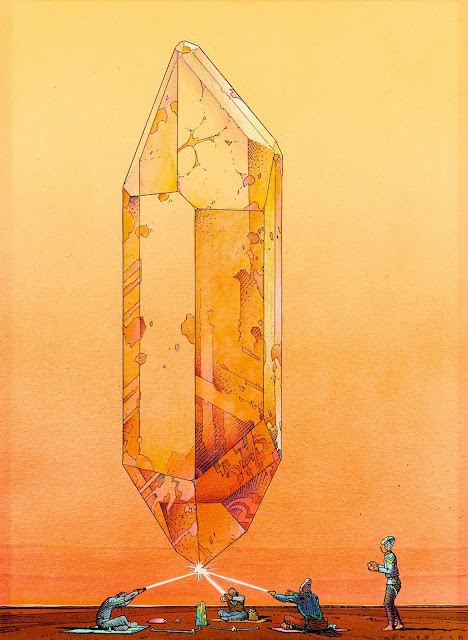French artist Jean Giraud who signed himself as GIR and MOEBIUS died last Saturday, March 10, 2012 aged 73. Drawing and painting since age 16, the artist left an amazing legacy of illustration and comic book art in a striking individual style unlike any other.
Born in Paris, France, in 1938. At age 16, in 1955, he began his only technical training at the Arts Appliqués art
school, where he started producing Western comics. He became close friends with
another comic artist Jean-Claude Mézières. In 1956 he left art school to visit
his mother in Mexico and he stayed there eight months, after which he returned
to work full time as an artist.
His famous work the Lieutenant Blueberry character, whose facial features
were based on those of French dramatic movie actor Jean-Paul Belmondo, was created in 1963 by
Charlier (script) and Giraud (drawings) for French magazine, Pilote, which quickly became
its most popular figure. His adventures as told in the spin-off Western serial
Blueberry, are possibly Giraud's best known work in his native France.The early Blueberry comics
used a simple line drawing style and standard Western
themes and imagery, but gradually Giraud developed a darker and grittier style
inspired by the Spaghetti Westerns of Sergio Leone and the dark realism of Sam
Peckinpah. With the fifth album, "The Trail of the Navajos",
Giraud established his own style, and after censorship laws were loosened in
1968 the strip became more explicitly adult, and also adopted a wider range of
thematics. "Angel Face", the first Blueberry album penciled by
Giraud after he had begun publishing science fiction as Moebius, was much more
experimental than his previous Western work.
Giraud left the series in 1973 leaving the artwork to Colin
Wilson, Michel Rouge and later Michel Blanc-Dumont for a few books. He returned
to it in the following decade, producing many more very successful Blueberry
stories, further increasing its already outstanding quality.
When Charlier, Giraud's collaborator on Blueberry died in
1989, Giraud assumed responsibility for the scripting of the series. Blueberry
has been translated into 15 languages, the first English translations by Marc
Lofficier being published in 1970. The original Blueberry series has spun off a
prequel series called "Young Blueberry", and a sequel called
"Marshall Blueberry".
The Moebius signature, which Giraud came to use for his science fiction and fantasy work, was introduced in 1963. In a satire magazine called Hara-Kiri, Moebius did 21 strips in 1963–64 and then disappeared for almost a decade.
The Moebius signature, which Giraud came to use for his science fiction and fantasy work, was introduced in 1963. In a satire magazine called Hara-Kiri, Moebius did 21 strips in 1963–64 and then disappeared for almost a decade.
In 1975 he revived the Moebius signature, and with
Jean-Pierre Dionnet, Philippe Druillet, and Bernard Farkas, he became one of
the founding members of the comics art group "Les Humanoides
Associes". Together they started the magazine Métal Hurlant, the magazine
known in the English as Heavy Metal .
Moebius' famous serial The Airtight Garage and his groundbreaking Arzach both began
in Métal Hurlant. In 1976 Metal Hurlant published The Long Tomorrow written by
Dan O'Bannon.
Arzach is a wordless comic, created in a deliberate attempt
to breathe new life into the comic genre which at the time was dominated by
American superhero comics. It tracks the journey of the title character flying
on the back of his pterodactyl through a fantastic world mixing medieval
fantasy with futurism. Unlike most science fiction comics it has no captions,
no speech balloons and no written sound effects. The
wordlessness provides the strip with a sense of timelessness, setting up Arzach's
journey as a quest for eternal, universal truths.
Comics, movie concepts and storyboards, Sci-fi, Fantasy were all part of Giraud's artistic endeavours and his death is a true loss to the world of popular art;
































